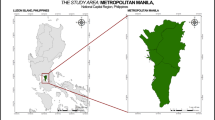Abstract
The gradient based landscape metrics analysis is now widely used to study the landscape pattern changes in respond to the urbanization. In order to discover the trend of spatio-temporal changes in Beijing metropolitan area during the past 15 years, several landscape metrics are computed using a moving window along a 96 km long transect across Beijing metropolitan area from west to east. Specially, the spatial extent of sub-landscape, which is determined by the moving window’s size, is profoundly examined. The results show that the metrics varies smoothly and regularly along the selected transect when the window size is greater than 6 km×6 km, and irregularly fluctuated for the smaller window size, that the spatial and temporal landscape characteristics of Beijing city match the hypothetical framework of spatio-temporal urban sprawl in the form of alternating processes of diffusion and coalescence well, and that some new trends of the urban sprawl style in Beijing metropolitan area, such as leap-frog manner, are also detected by the gradient landscape analysis.
Similar content being viewed by others
References
Redman C L. Human dimensions of ecosystem studies. Ecosyst, 1999, 2: 296–298
Bastian O. Landscape classification in Saxony (Germany) a tool for holistic regional planning. Landscape Urban Plan, 2000, 50: 145–155
Zhou Q, Li B, Kurhan A. Spatial pattern analysis of land cover change trajectories in Tarim Basin, northwest China. Int J Remote Sens, 2008, 29: 5495–5509
Forman R T, Godron M. Landscape Ecology. New York: Wiley, 1986
McDonnell M J, Pickett S T A. Ecosystem structure and function along urban-rural gradients: An unexploited opportunity for ecology. Ecology, 1990, 71: 1232–1237
Zhou Q, Li B, Kurban A. Trajectory analysis of land cover change in arid environment of China. Int J Remote Sens, 2008, 29: 1093–1107
Weng Y C. Spatiotemporal changes of landscape pattern in response to urbanization. Landscape Urban Plan, 2007, 81: 341–353
Dietzel C, Herold M, Hemphill J J, et al. Spatio-temporal dynamics in California’s Central Valley: Empirical links to urban theory. Int J Geogr Inf Sci, 2005, 19: 175–195
Herold M, Goldstein N C, Clarke K C. The spatiotemporal form of urban growth: Measurement, analysis and modeling. Remote Sens Environ, 2003, 86: 286–302
Herold M, Scepan J, Clarke K C. The use of remote sensing and landscape-metrics to describe structures and changes in urban land uses. Environ Plann A, 2002, 34: 1443–1458
Wei J, Jia M, Rima W T, et al. Characterizing urban sprawl using multi-stage remote sensing images and landscape metrics. Comput Environ Urban, 2006, 30: 861–879
Luck M, Wu J. A gradient analysis of urban landscape pattern: A case study from the Phoenix metropolitan region, Arizona, USA. Landscape Ecol, 2002, 17: 327–339
Hahs A K, McDonnell M J. Selecting independent measures to quantify Melbourne’s urban-rural gradient. Landscape Urban Plan, 2006, 78: 435–448
Yu X J, Ng C N. Spatial and temporal dynamics of urban sprawl along two urban-rural transects: A case study of Guangzhou, China. Landscape Urban Plan, 2007, 79: 96–109
Kong F H, Nobukazu N. Spatial-temporal gradient analysis of urban green spaces in Jinan, China. Landscape Urban Plan, 2006, 78: 341–353
Chen S P, Zeng S, Xie C G. Remote sensing and GIS for urban growth analysis in China. Photogramm Eng Rem S, 2000, 66: 593–598
He C Y, Okada N, Zhang Q F, et al. Modeling urban expansion scenarios by coupling cellular automata model and system dynamic model in Beijing, China. Appl Geogr, 2006, 26: 323–345
Xie Y C, Fang C L, Lin G C, et al. Tempo-spatial patterns of land use changes and urban development in globalizing China: A study of Beijing. Sensors, 2007, 7: 2881–2906
Woodcock C E, Allen A A. Free access to Landsat imagery. Science, 2008, 320: 1011
Zhou Q, Li B, Zhou C. Studying spatial-temporal patterns of landuse change in arid environment of China. In: Li Z, Zhou Q, Kainz W, eds. Advances in Spatial Analysis and Decision Making. Lisse: Swets & Zeitlinger, 2004. 189–200
Li B, Zhou Q. Accuracy assessment on multi-temporal land-cover change detection using a trajectory error matrix. Int J Remote Sens, 2009, 30: 1283–1296
Liu H, Zhou Q. Accuracy analysis of remote sensing change detection by rule-based rationality evaluation with post-classification comparison. Int J Remote Sens, 2004, 25: 1037–1050
McGarigal K, Cushman S A, Neel M C, et al. User Manual for FRAGSTATS: Spatial Pattern Analysis Programme for Categorical Maps, 2002
Turner M G. Landscape ecology: The effect of pattern on process. Annu Rev Ecol Syst, 1989, 20: 171–197
Wiens J A. Spatial scaling in ecology. Funct Ecol, 1989, 3: 385–397
Benson B J, MacKenzie M D. Effects of sensor spatial resolution on landscape structure parameters. Landscape Ecol, 1995, 10: 113–120
Frohn R C, Hao Y. Landscape metric performance in analyzing two decades of deforestation in the Amazon Basin of Rondonia, Brazil. Remote Sens Environ, 2006, 100: 237–251
Frohn R C, McGwire K C, Dale V H, et al. Using satellite remote sensing analysis to evaluate a socio-economic and ecological model of deforestation in Rondonia, Brazil. Int J Remote Sens, 1996, 17: 3233–3255
Garcia-Gigorro S, Saura S. Forest fragmentation estimated from remotely sensed data: Is comparison across scales possible? Forest Sci, 2005, 51: 51–63
Hlavka C A, Livingston G P. Statistical models of fragmented land cover and the effect of coarse spatial resolution on the estimation of area with satellite sensor imagery. Int J Remote Sens, 1997, 18: 2253–2259
Saura S, Carballal P. Discrimination of native and exotic forest patterns through shape irregularity indices: An analysis in the landscapes of Galicia, Spain. Landscape Ecol, 2004, 19: 647–662
Wu J. Effects of changing scale on landscape pattern analysis: Scaling relations. Landscape Ecol, 2004, 19: 125–138
Author information
Authors and Affiliations
Corresponding author
Rights and permissions
About this article
Cite this article
Yang, Y., Zhou, Q., Gong, J. et al. Gradient analysis of landscape spatial and temporal pattern changes in Beijing metropolitan area. Sci. China Technol. Sci. 53 (Suppl 1), 91–98 (2010). https://doi.org/10.1007/s11431-010-3206-2
Received:
Accepted:
Published:
Issue Date:
DOI: https://doi.org/10.1007/s11431-010-3206-2




